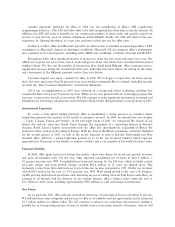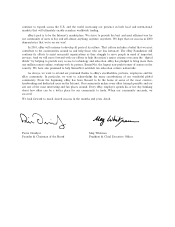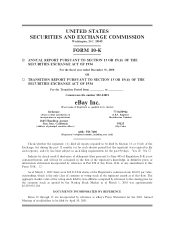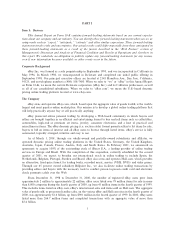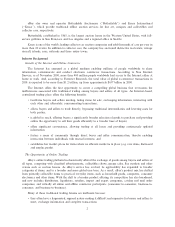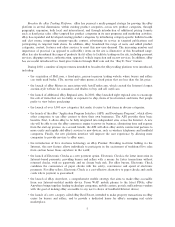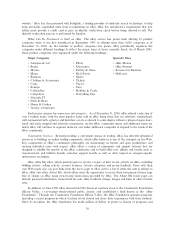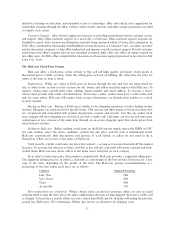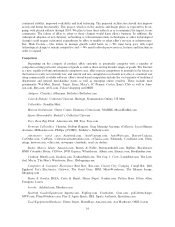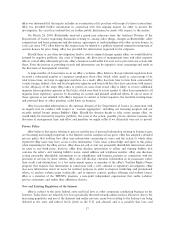eBay 2000 Annual Report Download - page 13
Download and view the complete annual report
Please find page 13 of the 2000 eBay annual report below. You can navigate through the pages in the report by either clicking on the pages listed below, or by using the keyword search tool below to find specific information within the annual report.on eBay. In November 2000, eBay implemented the ""Buy it Now'' feature. Sellers can choose to use the Buy
It Now feature at the time of listing, which allows sellers to name a price at which they would be willing to sell
the item to any buyer. Listings are run in the normal auction format, but will also feature a Buy It Now icon
and price. Until the Ñrst bid is placed, or in the case of a reserve auction, until the reserve price is met, buyers
have the option to buy the item instantly at the speciÑed price without waiting for the listing to end.
Selling on eBay. Sellers registered with eBay can list a product for sale by completing a short online
form or using ""Mr. Lister,'' ""Auction Assistant'' or third party tools that facilitate the listing of multiple items.
The seller selects a minimum price for opening bids for the item and chooses whether the sale will last three,
Ñve, seven or ten days. Additionally, a seller may select a reserve price for an item, which is the minimum
price at which the seller is willing to sell the item and is typically higher than the minimum price set for the
opening bid. The reserve price is not disclosed to bidders. A seller can elect to sell items in individual item
listings or, if he or she has multiple identical items, can elect to hold a ""Dutch Auction.'' For example, an
individual wishing to sell 10 identical watches could hold 10 individual auctions or hold a Dutch Auction in
which the 10 highest bidders would each receive a watch at the same price and all lower bids would be
rejected. To be eligible to hold a Dutch auction, a seller must have a suÇciently high feedback rating and
must have been a registered seller for at least 60 days. A seller may also specify that an auction will be a
private auction. With this format, bidders' e-mail addresses are not disclosed on the item screen or bidding
history screen.
Throughout 2000, sellers generally paid a nominal placement fee to list items for sale Ì $0.25 for an item
listing with a minimum starting price of less than $10.00; $0.50 for a minimum starting price of $10.00 to
$24.99; $1.00 for a minimum starting price of $25.00 to $49.99; and $2.00 for a minimum starting price of
$50.00 or more. As of January 31, 2001, listing fees were increased as follows Ì $0.30 for an item listing with
a minimum starting price of less than $10.00; $0.55 for a minimum starting price of $10.00 to $24.99; $1.10 for
a minimum starting price of $25.00 to $49.99; $2.20 for a minimum starting price of $50.00 to $199.99; and
$3.30 for a minimum starting price of $200 or more. By paying an additional $0.50 for items with a starting
price of $0.01 to $24.99 or $1.00 for items with a starting price of $25 or more, sellers can choose to have a
reserve selling price, which establishes a minimum level at which they are obligated to sell the item. By paying
incremental placement fees, sellers can have items featured in various ways. A seller can highlight his or her
item for sale by utilizing a bold font for the item heading for an additional fee of $2.00. A seller with a
favorable feedback rating can have his or her auction featured as a ""Featured Auction'' for $99.95, which
allows the seller's item to be rotated on the eBay home page, or as a ""Featured Plus!'' for $19.95, which allows
his or her item to appear in its category Featured Item section and in bidder's search results, and the item may
be selected for display in another area Ì the category index page Featured Items section. A seller can also
include a description of the product. In addition, a seller can include a photograph in the item's description if
the seller posts the photograph on a website and provides eBay with the appropriate Web address. Items may
be showcased in the Gallery section with a catalog of pictures rather than text. A seller who uses a photograph
in his or her listing can have this photograph included in the Gallery section for $0.25 or featured in the
Gallery section for $19.95. Certain categories of items, including real estate, automobiles and ""Premier'' have
diÅerent pricing. A seller can choose to list his or her item with the ""List in Two Categories'' feature, which
gives the item added visibility by listing it in two separate categories. The charge for ""List in Two Categories''
is double the insertion and optional feature fees (excluding home page featured). In addition, for $0.10 a seller
can choose to list his or her item for 10 days, the longest available duration. All pricing is subject to change.
How Transactions are Completed. When an auction ends, the eBay system validates if a bid exceeded
the minimum price, and the reserve price if one has been set. If the sale was successful, eBay automatically
notiÑes the buyer and seller via email and the buyer and seller can then consummate the transaction
independent of eBay. At the time of the email notiÑcation, eBay generally charges the seller a success fee
equal to 5% of the Ñrst $25 of the purchase price, 2.5% of that portion of the purchase price from $25.01 to
$1,000, and 1.25% of that portion of the purchase price over $1,000. At no point during the process does eBay
take possession of either the item being sold or the buyer's payment for the item. Rather, the buyer and seller
must independently arrange for the shipment of and payment for the item, with the buyer typically paying for
8


